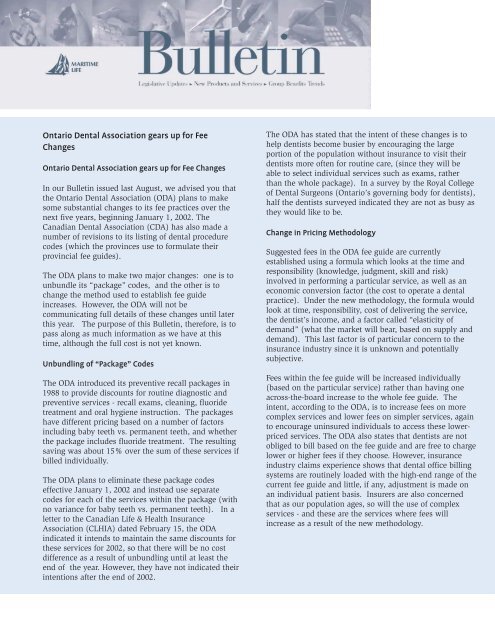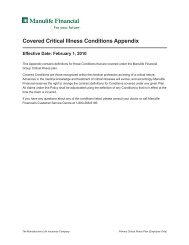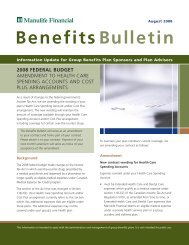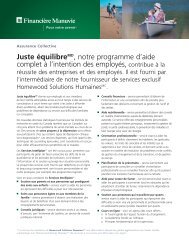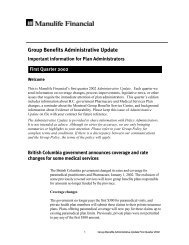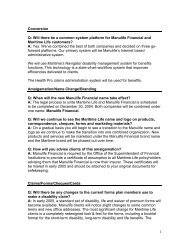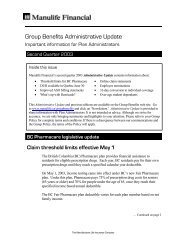Ontario Dental Association gears up for Fee Changes - Manulife
Ontario Dental Association gears up for Fee Changes - Manulife
Ontario Dental Association gears up for Fee Changes - Manulife
You also want an ePaper? Increase the reach of your titles
YUMPU automatically turns print PDFs into web optimized ePapers that Google loves.
<strong>Ontario</strong> <strong>Dental</strong> <strong>Association</strong> <strong>gears</strong> <strong>up</strong> <strong>for</strong> <strong>Fee</strong><br />
<strong>Changes</strong><br />
<strong>Ontario</strong> <strong>Dental</strong> <strong>Association</strong> <strong>gears</strong> <strong>up</strong> <strong>for</strong> <strong>Fee</strong> <strong>Changes</strong><br />
In our Bulletin issued last August, we advised you that<br />
the <strong>Ontario</strong> <strong>Dental</strong> <strong>Association</strong> (ODA) plans to make<br />
some substantial changes to its fee practices over the<br />
next five years, beginning January 1, 2002. The<br />
Canadian <strong>Dental</strong> <strong>Association</strong> (CDA) has also made a<br />
number of revisions to its listing of dental procedure<br />
codes (which the provinces use to <strong>for</strong>mulate their<br />
provincial fee guides).<br />
The ODA plans to make two major changes: one is to<br />
unbundle its “package” codes, and the other is to<br />
change the method used to establish fee guide<br />
increases. However, the ODA will not be<br />
communicating full details of these changes until later<br />
this year. The purpose of this Bulletin, there<strong>for</strong>e, is to<br />
pass along as much in<strong>for</strong>mation as we have at this<br />
time, although the full cost is not yet known.<br />
Unbundling of “Package” Codes<br />
The ODA introduced its preventive recall packages in<br />
1988 to provide discounts <strong>for</strong> routine diagnostic and<br />
preventive services - recall exams, cleaning, fluoride<br />
treatment and oral hygiene instruction. The packages<br />
have different pricing based on a number of factors<br />
including baby teeth vs. permanent teeth, and whether<br />
the package includes fluoride treatment. The resulting<br />
saving was about 15% over the sum of these services if<br />
billed individually.<br />
The ODA plans to eliminate these package codes<br />
effective January 1, 2002 and instead use separate<br />
codes <strong>for</strong> each of the services within the package (with<br />
no variance <strong>for</strong> baby teeth vs. permanent teeth). In a<br />
letter to the Canadian Life & Health Insurance<br />
<strong>Association</strong> (CLHIA) dated February 15, the ODA<br />
indicated it intends to maintain the same discounts <strong>for</strong><br />
these services <strong>for</strong> 2002, so that there will be no cost<br />
difference as a result of unbundling until at least the<br />
end of the year. However, they have not indicated their<br />
intentions after the end of 2002.<br />
The ODA has stated that the intent of these changes is to<br />
help dentists become busier by encouraging the large<br />
portion of the population without insurance to visit their<br />
dentists more often <strong>for</strong> routine care, (since they will be<br />
able to select individual services such as exams, rather<br />
than the whole package). In a survey by the Royal College<br />
of <strong>Dental</strong> Surgeons (<strong>Ontario</strong>’s governing body <strong>for</strong> dentists),<br />
half the dentists surveyed indicated they are not as busy as<br />
they would like to be.<br />
Change in Pricing Methodology<br />
Suggested fees in the ODA fee guide are currently<br />
established using a <strong>for</strong>mula which looks at the time and<br />
responsibility (knowledge, judgment, skill and risk)<br />
involved in per<strong>for</strong>ming a particular service, as well as an<br />
economic conversion factor (the cost to operate a dental<br />
practice). Under the new methodology, the <strong>for</strong>mula would<br />
look at time, responsibility, cost of delivering the service,<br />
the dentist’s income, and a factor called “elasticity of<br />
demand” (what the market will bear, based on s<strong>up</strong>ply and<br />
demand). This last factor is of particular concern to the<br />
insurance industry since it is unknown and potentially<br />
subjective.<br />
<strong>Fee</strong>s within the fee guide will be increased individually<br />
(based on the particular service) rather than having one<br />
across-the-board increase to the whole fee guide. The<br />
intent, according to the ODA, is to increase fees on more<br />
complex services and lower fees on simpler services, again<br />
to encourage uninsured individuals to access these lowerpriced<br />
services. The ODA also states that dentists are not<br />
obliged to bill based on the fee guide and are free to charge<br />
lower or higher fees if they choose. However, insurance<br />
industry claims experience shows that dental office billing<br />
systems are routinely loaded with the high-end range of the<br />
current fee guide and little, if any, adjustment is made on<br />
an individual patient basis. Insurers are also concerned<br />
that as our population ages, so will the use of complex<br />
services - and these are the services where fees will<br />
increase as a result of the new methodology.
CDA Procedure Code <strong>Changes</strong><br />
The CDA has made some 400 revisions to its procedure<br />
code list which the provincial dental associations use<br />
to develop their fee guides (all provinces except<br />
Quebec use the same codes in an ef<strong>for</strong>t to s<strong>up</strong>port<br />
uni<strong>for</strong>mity across the country). A large percentage of<br />
these changes will have no effect on dental plans<br />
because they are merely wording changes, or they<br />
relate to procedures not normally covered by dental<br />
plans. Of the codes that are covered by dental plans,<br />
some new codes have been added, <strong>for</strong> example, to<br />
s<strong>up</strong>port advances in dentistry and dental techniques.<br />
Maritime Life is working with the Canadian Life &<br />
Health Insurance <strong>Association</strong> to assess what impact<br />
these revisions will have on dental costs.<br />
What do these changes mean <strong>for</strong> gro<strong>up</strong> plans<br />
In the meantime, <strong>for</strong> plan sponsors who wish to<br />
proactively move to manage the impact of these changes<br />
on their plan, there are a number of design ideas that can<br />
be considered. Examples are:<br />
• introducing an annual dollar maximum at the overall<br />
dental benefit level or on major dental services only;<br />
• increased cost-sharing with plan members (ie. coinsurance<br />
and deductibles);<br />
• adjusting frequency limits; or<br />
• reimbursing at other than the current fee guide.<br />
Plan sponsors who wish to explore these concepts should<br />
contact their Maritime Life representative.<br />
The insurance industry has no doubt that the effect of<br />
these changes will be to increase dental plan costs.<br />
While the level of those increases is not yet known,<br />
estimates range from 15% to 20% over five years. In<br />
addition, insurers are concerned that unbundling of the<br />
package codes will result in considerable disr<strong>up</strong>tion to<br />
patients and plan sponsors, as well as costly<br />
adjustments and corrections, while dentists and dental<br />
plans adjust to the new billing practices. The cost to<br />
insurers to modify their claims systems is also<br />
significant.<br />
The CLHIA (of which Maritime Life is a member) has<br />
made presentations to the ODA outlining our concerns.<br />
The ECHCO Gro<strong>up</strong> (<strong>Ontario</strong>’s Employer Committee on<br />
Health Care) and the Canadian Auto Workers have<br />
made similar presentations and in fact, all three of<br />
these gro<strong>up</strong>s have been working together to deliver a<br />
strong and consistent message to the ODA. We have<br />
indicated that we are not opposed to reasonable<br />
increases in the fee guide if they result in added value<br />
to patients and dental plans. We have advised that we<br />
are willing to work cooperatively with the ODA to find<br />
an appropriate compromise. However, we have also<br />
indicated that the industry will be looking at<br />
alternative options if we are unable to reach a solution<br />
which protects our clients from unduly high increases<br />
in dental plan costs.


